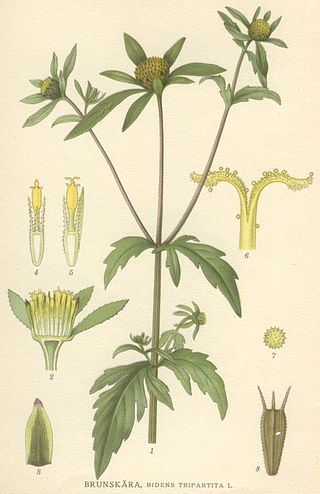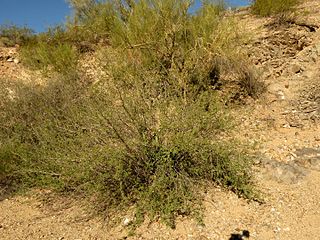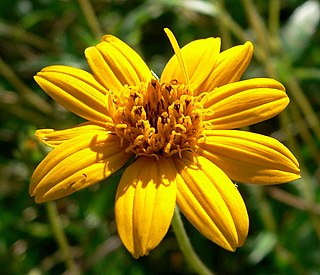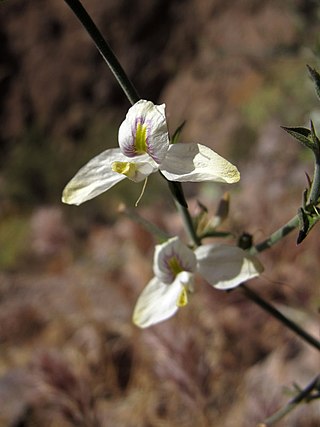
Gaillardia is a genus of flowering plants in the family Asteraceae, native to North and South America. It was named after Maître Gaillard de Charentonneau, an 18th-century French magistrate who was an enthusiastic botanist. The common name may refer to the resemblance of the inflorescence to the brightly patterned blankets made by Native Americans, or to the ability of wild taxa to blanket the ground with colonies. Many cultivars have been bred for ornamental use.

Buddleja is a genus comprising over 140 species of flowering plants endemic to Asia, Africa, and the Americas. The generic name bestowed by Linnaeus posthumously honoured the Reverend Adam Buddle (1662–1715), an English botanist and rector, at the suggestion of Dr. William Houstoun. Houstoun sent the first plants to become known to science as buddleja to England from the Caribbean about 15 years after Buddle's death. Buddleja species, especially Buddleja davidii and interspecific hybrids, are commonly known as butterfly bushes and are frequently cultivated as garden shrubs. Buddleja davidii has become an invasive species in both Europe and North America.

Bidens is a genus of flowering plants in the aster family, Asteraceae. The genus include roughly 230 species which are distributed worldwide. Despite their global distribution, the systematics and taxonomy of the genus has been described as complicated and unorganized. The common names beggarticks, black jack, burr marigolds, cobbler's pegs, Spanish needles, stickseeds, tickseeds and tickseed sunflowers refer to the fruits of the plants, most of which are bristly and barbed. The generic name refers to the same character; Bidens comes from the Latin bis ("two") and dens ("tooth").

Custard apple is a common name for several fruits and may refer to Annonaceae, the custard apple family, which includes the following species referred to as custard apples:

Cercocarpus, commonly known as mountain mahogany, is a small genus of at least nine species of nitrogen-fixing flowering plants in the rose family, Rosaceae. They are native to the western United States and northern Mexico, where they grow in chaparral and semidesert habitats and climates, often at high altitudes. Several are found in the California chaparral and woodlands ecoregion.

Coursetia is a genus of flowering plants in the pea family, Fabaceae. Members of the genus, commonly known as babybonnets, are shrubs and small trees native to the Southwestern United States, Mexico, the Caribbean, Central America, and South America as far south as Brazil and Peru. The genus is named for French botanist Georges Louis Marie Dumont de Courset (1746–1824).

Parkinsonia, also Cercidium, is a genus of flowering plants in the pea family, Fabaceae. It contains about 12 species that are native to semi-desert regions of Africa and the Americas. The name of the genus honors English apothecary and botanist John Parkinson (1567–1650).

Choisya is a small genus of aromatic evergreen shrubs in the rue family, Rutaceae. Members of the genus are commonly known as Mexican orange due to the similarity of their flowers to those of the closely related orange, both in shape and scent. They are native to southern North America, from Arizona, New Mexico, Texas and south through most of Mexico. In its generic name Humboldt and Bonpland honoured Swiss botanist Jacques Denis Choisy (1799–1859).

Sphagneticola trilobata, commonly known as the Bay Biscayne creeping-oxeye, merigold Singapore daisy, creeping-oxeye, trailing daisy, and wedelia, is a plant in the tribe Heliantheae of the family Asteraceae. It is native to Mexico, Central America, and the Caribbean, but now grows throughout the Neotropics. It is widely cultivated as an ornamental groundcover.

Lippia is a genus of flowering plants in the verbena family, Verbenaceae. It was named after Augustus Lippi, (1678-1705), a French naturalist and botanist. He was killed in Abyssinia. The genus contains roughly 200 species of tropical shrubs that are found around the world. Plants are fragrant due to their essential oils, which vary between species but may include estragole, carvacrol, linalool, or limonene. The leaves of certain species, such as L. graveolens, can be used as a culinary herb similar to oregano.

Viguiera is a genus of flowering plants in the family Asteraceae. It contains around 19-40 species, which are commonly known as goldeneyes and are native to the New World. These are herbs to bushy shrubs that bear yellow or orange daisy-like flowers.

Wedelia is a genus of flowering plants in the family Asteraceae. They are one of the genera commonly called "creeping-oxeyes".

Amyris is a genus of flowering plants in the citrus family, Rutaceae. The generic name is derived from the Greek word αμυρων, which means "intensely scented" and refers to the strong odor of the resin. Members of the genus are commonly known as torchwoods because of their highly flammable wood.

Carlowrightia is a genus of flowering plants in the bear's breeches family, Acanthaceae. Members of the genus, commonly known as wrightworts, are mainly small shrubs bearing inflorescences of lily-like flowers. They are native to the Americas, with many species found in western North America. The genus was named for the American botanist Charles Wright.

Thamnosma is a genus of flowering plants in the rue family, Rutaceae. Plants in this genus are sometimes known by the common name desertrue.

Wissadula is a genus of flowering plants in the mallow family, Malvaceae. It contains 25 to 30 species of herbs and subshrubs that are mostly native to the Neotropics, with several in tropical Asia and Africa. The name is derived from the Sinhala language.

Sideroxylon celastrinum is a species of flowering plant in the family Sapotaceae, that is native to Texas and Florida in the United States south through Central America to northern Venezuela and Colombia in South America. Common names include saffron plum and coma. It is a spiny shrub or small tree that reaches a height of 2–9 m (6.6–29.5 ft). The dark green leaves are alternate or fascicled at the nodes and oblanceolate to obovate. Greenish-white flowers are present from May to November and are followed by single-seeded, blue-black drupes.
Zexmenia is a genus of Latin American plants in the tribe Heliantheae within the family Asteraceae.

Lipochaeta, common name nehe, is a genus of flowering plants in the family Asteraceae that is endemic to Hawaii.

Leavenworthia is a genus of flowering plants in the family Brassicaceae. It includes about eight species native to the southern and southeastern United States. They are known generally as gladecresses.




















